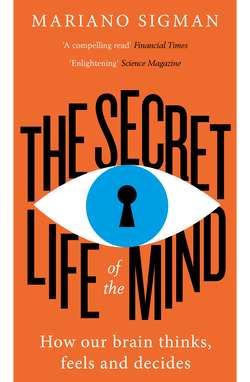Читать книгу The Secret Life of the Mind: How Our Brain Thinks, Feels and Decides - Mariano Sigman - Страница 11
The mirror between perception and action
ОглавлениеOur representation of time is random and fickle. The phrase ‘Christmas is fast approaching’ is strange. Approaching from where? Does it come from the south, the north, the west? Actually, Christmas isn’t located anywhere. It is in time. This phrase, or the analogous one, ‘we’re getting close to the end of the year’, reveals something of how our minds organize our thoughts. We do it in our bodies. Which is why we talk of the head of government, of someone’s right-hand man, the armpit of the world and many other metaphorsfn1 that reflect how we organize thought in a template defined by our own bodies. And because of that, when we think of others’ actions, we do so by acting them out ourselves, speaking others’ words in our own voice, yawning someone else’s yawn and laughing someone else’s laugh. You can do a simple experiment at home to test out this mechanism. During a conversation, cross your arms. It’s very likely that the person you are speaking to will do the same. You can take it further with bolder gestures, like touching your head, or scratching yourself, or stretching. The probability that the other person will imitate you is high.
This mechanism depends on a cerebral system made up of mirror neurons. Each one of these neurons codifies specific gestures, like moving an arm or opening up a hand, but it does so whether or not the action is our own or someone else’s. Just as the brain has a mechanism that spontaneously amalgamates information from different sensory modes, the mirror system allows – also spontaneously – our actions and others’ actions to be brought together. Lifting your arm and watching someone else do it are very different processes, since one is done by you and the other is not. As such, one is visual and the other is motor. However, from a conceptual standpoint, they are quite similar. They both correspond to the same gesture in the abstract world.
And now after understanding how we adults merge sensory modalities in music, in shapes and sounds and in language, and how we bring together perception and action, we go back to the infant mind, specifically to ask whether the mirror system is learned or whether it is innate. Can newborns understand that their own actions correspond to the observation of another person’s? Meltzoff also tested this out, to put an end to the empirical idea that considers the brain a tabula rasa.
Meltzoff proposed another experiment, in which he made three different types of face at a baby: sticking out his tongue, opening his mouth, and pursing his lips as if he were about to give the child a kiss. He observed that the baby tended to repeat each of his gestures. The imitation wasn’t exact or synchronized; the mirror is not a perfect one. But, on average, it was much more likely that the baby would replicate the gesture he or she observed than make one of the other two. Which is to say that newborns are capable of associating observed actions with their own, although the imitation is not as precise as it will later become when language is introduced.
Meltzoff’s two discoveries – the associations between our actions and those of others, and between varying sensory modalities – were published in 1977 and 1979. By 1980, the empirical dogma was almost completely dismantled. In order to deal it a final death blow, there was one last mystery to be solved: Piaget’s mistake.fn2
